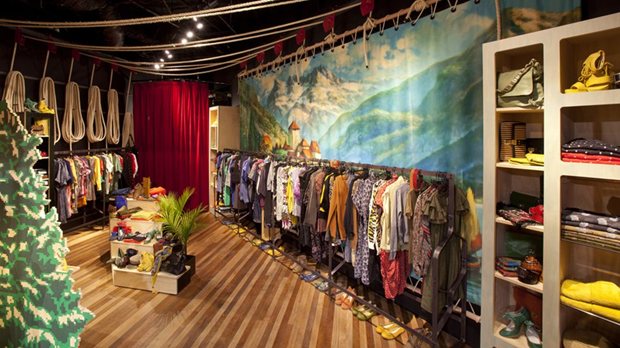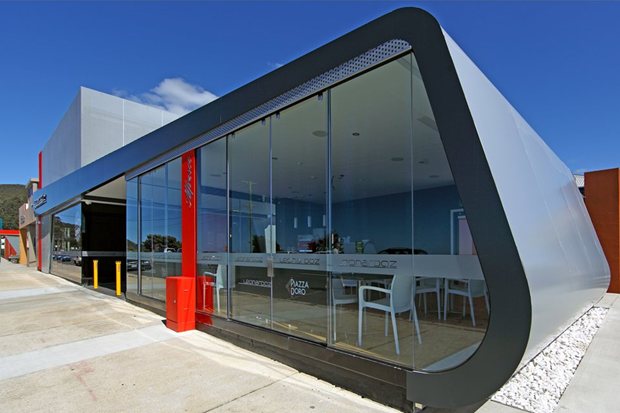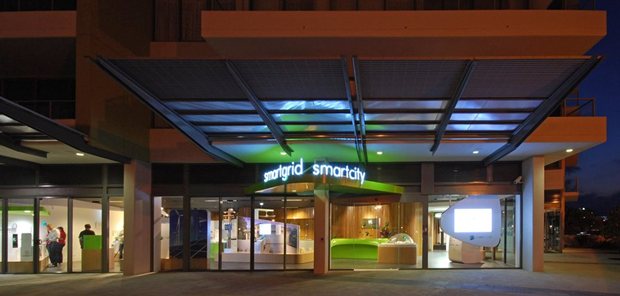LULAMAE BOUTIQUE
Lulamae Boutique by Breathe Architecture
The brief was to fitout a small retail space for a boutique shop in Melbourne Central.
Employing a backdrop of pixelated imagery digitally printed on plywood and canvas - distinguishable at relative distances, the set is enclosed with red velvet curtains, rope tie downs and mild steel detailing. Installed as a stage set, complete with proscenium arch, tree flats and backdrop – the structure is raw, exposed and unashamedly visible from within.
As retail fitouts historically have a short life expectancy the architects wanted to create maximum impact with the smallest possible footprint. Fundamentally we adopted a reductionist approach. Our key goal was to find a concept design strategy that could make the most of a wedge shaped tenancy, and maximize any thermal mass available. We understood the temporal nature of the retail fitout. The entire design is constructed out of lightweight low embodied energy, local and recycled materials. There is no aluminium or chrome in this project. The only applied finishes to any material are - Porters zero VOC milk paint to the joinery, ecolour zero VOC blackout paint (made from recycled engine oil) and bees wax to floors and edges of form ply joinery.
INNOVATIONS
-
Recycled 60X19 Tas Oak flooring (top nailed, no glue)
-
Australian Plantation Form Ply as joinery
-
Australian Hoop Pine Ply as joinery
-
Australian Radiata Ply as proscenium arch, wings and stage flats
-
Mild steel as racking and window and door framing (finished with bees wax coating)
-
500meters of rope manufactured in WA
-
Remnant Rolls of fabric sourced for curtains

-
The big savings in this fitout are about resources and material selection
-
Material palette kept to a simple list of low embodied local material:
-
Recycled 60X19 Tas Oak flooring (top nailed, no glue)
-
Australian Plantation Form Ply as joinery
-
Australian Hoop Pine Ply as joinery
-
Australian Radiata Ply as proscenium arch, wings and stage flats
-
Mild steel as racking and window and door framing (finished with bees wax coating)
-
500meters of rope manufactured in WA
-
Remnant Rolls of fabric sourced for curtains
-
LED light fittings
-
Ecolour Blackout paint (zero VOC and made from recycled engine oil)
-
Porters milk paint (zero VOC)
-
Bio Products hard floor wax
THE NATIONAL HOTEL
The National Hotel submitted by Breathe Architecture
The National Hotel was a Victorian era pub that over a hundred years and a series of bad renovations, had fallen from grace.
The architects said that they approached the project with a utilitarian sensibility: everything is robust and unpretentious, everything serves a purpose. A rich and textural palette of recycled materials replaces the typical use of high embodied energy building products. There is no tiling, carpet, chrome, aluminium or plasterboard in this project. The few painted surfaces employ zero VOC paint, manufactured locally from recycled engine oil.
The existing building stock had large sealed windows on the north façade. All the thermal mass in the building was covered with layers of plasterboard, MDF and layers of sticky carpet. The existing heating and cooling strategy hinged on a string of window mounted air conditioning boxes blowing hot and cold air into a tightly sealed box. With a tight budget we had to work closely with the client to look at life cycle costs for the building to encourage them to adopt numerous sustainability strategies with commercial payback.
INITIATIVES
-
A new awning was designed to shade the North facing glazing and was calculated to allow winter solar access only. This awning was made from a recycled truck tarpaulin (complete with hundreds of hand sewn patches) stretched over a mild steel frame.
-
The interior walls were stripped of plasterboard & imitation wood panelling, whilst layers of sticky carpet were peeled from the floor.
-
The remaining concrete floor & masonry walls were exposed to harness their thermal mass.
-
The existing fixed glass windows were replaced with operable performance glass to allow the space to be naturally ventilated.
-
The natural ventilation was augmented with wall mounted fans & evaporative cooling.
-
All of the refrigeration equipment for the bar has been specified with remote condensers (taking all of the heat loading from under the bar to outside the building)
-
The ice machine has been located on an external wall and its condenser is vented directly to outside air.
-
The entire south wall of the hotel opens up to the courtyard to the south. The entire wall of the dining room can be opened up via massive sliding doors in summer & close down in winter.
-
The rear courtyard was enclosed with a 3m bagged-recycled brick wall for acoustic protection of the neighbours and then planted out with tall clumping bamboo to the west.
-
2.6kw Bosch Solar array
-
400litre gas boosted evacuated tube solar hot water system.
-
LED and CFL lighting
-
Infrared natural gas radiant heating (onto thermal mass)
-
Solar gain reduction in warmer months (with new awning)
-
Natural Ventilation (new operable windows)
-
Wall fans
-
Evaporative Cooling (to augment natural ventilation if required)
-
Water Efficiency

-
9000 litres of rainwater stored in 9 x 1000 stackable poly-boy tanks. This water is used to flush the toilets & water the garden.
-
Waterless urinal system.
-
Caroma smart flush 4.5 / 3litre toilet suites.
-
Recycled timber and tarpaulin cushions form large seating clusters around concrete and steel tables. All concrete on this project is E-crete containing recycled fly-ash. Steel cages overrun by vines separate the booths from each other.
-
Recycled fence palings cut to form timber tiles reminiscent of the exposed lath and plaster ceilings above, hold recycled polyester acoustic batts and provide acoustic attenuation for intimate discussions.
-
The courtyard, decked in recycled boards, is enclosed by tall, recycled brick walls from which a repurposed army tent has been stretched out taut to shade perimeter banquette seating clad with old stair timbers.
-
Exterior partition walls of mismatched concrete blocks laid on their side in a hit and miss pattern, provide separation, connection, texture and shadow play. 5-watt compact fluorescent lamps in amber glass bottles hang from catenary wires across the courtyard, abstracting Chinese lantern strings.
-
A 2.5kW solar panel array and a solar hot water system complements the low energy output of the National. With climate management left to occupant sensibility, refrigerative conditioning is non-existent. Forming an unpretentious layer to the bagged recycled brick backdrop of the walled courtyard, rainwater is collected in black recycled caged tanks, plumbed to the toilets.
-
A concealed services platform locates of refrigeration equipment remotely to reduce internal heat loading, while also housing kitchen plants and a worm farm.
LEONARDOZ
Leonardoz submitted by Clever Design
The brief was to utilise an existing 1950’s dilapidated motorcycle shop and convert it into a landmark restaurant, winebar and take-away dining services for a varied clientele. An additional afresco building was also required to be designed in the front yard of the adjacent building also owned by the client.
The sustainability challenges were around utilisation of an existing site. The existing building was a dilapidated 1950’s motorcycle shop and showroom. Above the existing showroom, a residential apartment was located on the 1st floor which was built to the eastern boundary and adjoined to the neighbouring church. The site complexities included a 6.0m allowable new build area from the boundary/footpath of the adjacent building and planning compliance for parking spaces with single one-way entry and egress. Site investigation revealed that only the front double storey section of the main building was structurally sound whilst the rear construction was of poor standard.
INITIATIVES
-
The new Alfresco building has been designed to incorporate passive solar heating and cooling to the utmost whilst exploiting the vast water views. It has northern orientation and extensive insulation has been used throughout.
-
New roof framing was utilised.
-
Locally manufactured engineered hybrid plantation grown timber structure.
-
Low-allergen products include the utilisation of Dulux Enviro2 low voc paints to ensure low emissions to the environment and impregnated low voc sealer in lieu of traditional polyurethane to polished concrete floor substantially reduced the toxins.

-
The whole life cycle impact of the building was considered. The bulk of the existing building was retained rather than demolition thereby significantly minimising the environmental impact by reclaiming the embodied energy.
-
Stand-out sustainability feature of this project is the ability to utilise the bulk of the existing envelope/frame, the complex constraints and challenging brief to conceive an innovative, definitive building form that is iconic in the streetscape and facilitates a multiplicity of uses to co-exist. Through the distinctive bold curved form two volumes unite as one allowing spatial interconnectivity and distinction of dining services. The resolve for the alfresco dining wing was created by utilising the 6.0m available space in the front yard of the existing adjacent building whilst cleverly camouflaging the existing building at the rear. Simultaneously, the interconnecting volumes serve to address car parking planning compliance with entry thoroughfare in-between the two volumes and egress to the western side. Continuing the distinctive form, perforated mesh façade spanning two storeys provides a new skin, camouflaging the apartment above and providing additional privacy for the clients.
SMART GRID SMART CITY INFORMATION CENTRE
Smart Grid Smart City Information Centre submitted by Schreiber Hamilton Architecture
Following being awarded the Federal Government’s Smart Grid – Smart City (SGSC) Project, an initiative to research and gather information about the costs and benefits of smart grids to inform future policy making, Ausgrid was charged with the responsibility of rolling out of new smart technologies across the network to improve the reliability of electrical supply and help reduce the cost of maintaining the network.
As a working advertisement for the “Smart Grid Smart City” (SGSC) Programme, the facility incorporates various technology displays, both static and interactive; accommodates demonstrations and the engagement of the public with Ausgrid project staff, as well as catering for community, stakeholder and industry meetings, workshops and events.
The design objective of the Smart Grid, Smart City Information Centre was to provide a showcase for efficient, sustainable design aimed at average home owners and home buyers, small to medium business owners and community groups. It was to provide public facilities to showcase energy sustainability information, options and products and to include interactive exhibition displays promoting examples of sustainable energy-efficient technology.
INITIATIVES
-
Recycled timber, extensive use of natural light, low energy lighting and power options, water-efficient taps and toilets, recycled flooring and ceiling, and fittings and furniture made from recycled materials were all utilised in the build.
-
Other design features with a sustainable focus, include:
-
The scale of the project is well-suited to the nature of the project.
-
The built form of the project includes individual energy-efficient and water-efficient exhibition display suites throughout the Information Centre.

-
Natural light and ventilation opportunities have been maximised to reduce reliance on artificial lighting, minimise energy consumption and take advantage of the temperate climate.
-
Floors: Recycled rubber resilient sheeting, incorporating recycled car tyres and other recycled rubber materials. Bamboo engineered flooring which is highly durable, harvested from sustainable sources, non toxic and includes low VOC adhesives and coatings.
-
Walls: Feature timber wall fabricated from Ausgrid recycled power poles and milled to a custom profile and then “scribbled” across the rear wall of the tenancy.
-
Ceilings: Echopanel acoustic panels, produced from recycled and recyclable PET plastic (with approximately 60% of PET sourced from post consumer waste materials).
-
Bench tops: Engineered stone with post manufacturing waste materials incorporated as a recycled element.
-
Joinery: Exhibition joinery incorporates X-board Kraft as carcassing, which is a sustainable alternative to MDF, and recyclable at end of life. It is ideal for the relatively short intended design life of the exhibition displays.
-
Demolition and preparation of the tenancy was undertaken in a manner that allows simple reinstatement at the conclusion of the tenancy.
-
While the project was in effect a tenancy fitout only, demolition and preparation was undertaken in a manner that allows simple reinstatement at the conclusion of the tenancy.
-
Additionally, daylight mesh stacking chairs are partially constructed from recycled car batteries, which can be recycled at the end of their life.

